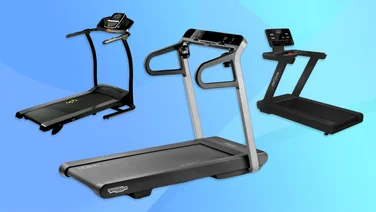To help us provide you with free impartial advice, we may earn a commission if you buy through links on our site. Learn more

- Sleek, compact rowing machine
- Hundreds of on-demand workouts
- Live leaderboards and music to motivate
- It’s still a relatively massive piece of kit
- Not as smooth in action as its larger sibling
- Screen doesn’t swivel
The original Hydrow Rower launched in the middle of a pandemic, which could either be viewed as a blessing or a curse for a burgeoning fitness tech company.
On the one hand, it rode the wave of popularity surrounding home fitness, following hard on the heels of the Peloton Bike and Tread devices. Its catalogue of on-demand workouts, led by professional rowers, allowed those stuck at home to experience the open water and receive rowing tips from the pros whenever and wherever they pleased.
On the other hand, Hydrow, like so many fitness tech companies, now faces the issue of an increasingly demanding customer base. Namely those unwilling to turn already cramped living rooms into home gyms, as well as those struggling with the ever-increasing cost of living, reducing the amount of spare cash available to splash on luxuries. And, of course, gyms are open again, so why not just use their rowing machines?
The Hydrow Wave is a direct response to all of these potential issues, offering a 30% smaller overall package (compared to the original Rower) along with a £200 cost saving. The only compromises Wave customers have to put up with is a smaller, non-adjustable touchscreen (it doesn’t pivot for off-rower workouts) and a seat and slide system that has fewer rollers, meaning the experience isn’t quite as smooth.
But make no mistake, it’s still a great motivator and a fantastic rowing machine, offering a serious strength and cardio workout that incorporates almost every muscle group in the body.
What do you get for the money
The Hydrow Wave (available in four colours) arrives in several pieces and will take most mildly competent DIYers under an hour to assemble. It’ll require the use of an Allen key or two but the process basically involves bolting the main sections together and fitting the 16in screen. Alternatively, Hydrow offers a professional in-home assembly at an additional cost.

Once set up, all you need to do is punch in a Wi-Fi password – a must if you want to access the video-based workouts and live leaderboards – and then commit to the £38 per month subscription for the Hydrow All-Access Membership. Ouch.
This unlocks the Peloton-esque service which delivers more than 4,000 on-demand rowing workouts with real instructors, rowing on real (and really picturesque) bodies of water. There are also daily live workouts, live leaderboards (so you can compete against other users), continuous stat tracking and milestone rewards, like badges and other motivators.
In all honesty, the Hydrow Wave would be fairly one dimensional without this membership, as it would simply be a more attractive version of other existing magnetic-resistance rowers that can be found on the market for much less.
READ NEXT: The best gym gloves to buy
What are the live classes like?
Anyone who has experienced a Peloton class will be well versed in the sunny chatter and motivational mutterings of the instructors. Hydrow has opted to follow a similar presentation pattern, with a healthy smattering of rowing technique pointers thrown in for good measure.

Essentially, you are rowing along with a professional as they effortlessly glide across a beautiful body of water, chatting to a camera that’s mounted to a tracking boat. You’ll get a number of different experiences, depending on the instructor, with some preferring to stick to dispensing technical advice, while others take a more whimsical approach.
The workouts are also split into three camps: Breathe, Sweat and Drive. The former is a more relaxing affair, for those who perhaps want to warm-up or wind down after a long day.
Sweat cranks the difficulty up a notch and Drive is for those who want to seriously burn some calories and kick some butt. That said, the difficulty of the classes is really only set by the instructor, who will inform you to adjust your strokes per minute speed (displayed on screen) and your time per 500m output (also displayed) in a sort of High Intensity Interval Training style. The rest is down to the work you put in.
It’s possible to manually adjust the resistance, via a slider on the display screen, but Hydrow says the standard setting should be fine for most as it most realistically replicates rowing on water.
As with Peloton, you’ll find that the live leaderboard is a good motivator to go harder during a session but, just like Peloton, you’ll also find that plenty of users pay no attention whatsoever to the instructor, haring off as soon as the session starts and then rowing like maniacs in order to sit atop the virtual table. Kind of pointless, but to be expected.
Just as with Peloton, and lots of other virtual training partner apps for that matter, workout sessions can be filtered by instructor, length, intensity, music type and even workout type, with Pilates, strength and core workouts all available to exercise along to.
READ NEXT: The best protein powder to buy
How does the rowing machine compare to rivals?
The Wave, like its larger sibling, uses a magnetic flywheel to create resistance. The electromechanical drag mechanism can be adjusted from a setting of 50 to 300 via an on-screen slider, although it’s set at 104 straight out of the box (said to offer the most realistic ‘feel’).

We found the default setting to be punchy enough even for advanced rowers, but the stroke feel isn’t quite as convincing as that found on fan-resistance models or, indeed, water-based rivals from WaterRower.
The initial ‘catch’ portion of the rowing stroke can also feel a bit notchy and it’s not as smooth as a Concept2 or a WaterRower, in our opinion.
But the benefit of this system is that it’s far quieter than fan resistance rivals, such as the Concept2 RowErg, and water-based models like the WaterRower. There’s only a faint whir of the electromechanical drag system with every stroke, the most noise emanating from the seat and slide system rolling back and forth.
Thanks to this, it’s possible to truly enjoy the workouts via the two-channel, 3W front-facing speakers that are built into the 41cm touchscreen display, which in turn is elegantly bolted onto the rowing machine itself.
READ NEXT: Concept2 RowErg rowing machine review
Alternatively, it’s really simple to pair Bluetooth headphones via an option in the setting menu, while Bluetooth and Ant+ enabled heart rate monitors can also be synced with the system in exactly the same way.
The only other downside of the Wave is the seat, which features two rollers, as opposed to the ten found on the original Hydrow Rower. We noticed the difference here, as it didn’t feel as smooth as the original model, while there’s also a small amount of lateral play.

Hydrow could also expend some effort on making the seat itself more comfortable. There’s not a huge amount of cushioning which can easily lead to a numb bum, especially when undertaking a relatively epic rowing session.
How much experience do I need to use it?
None really. Hydrow is committed to getting as many people into rowing as possible, so offers all manner of tuition videos that help with technique.
In my eyes, at least, this is one of the best features of the Hydrow ecosystem. It’s great having professional rowers on hand to build strength, improve stroke technique and generally help you get better at it.
However, the comparisons with Peloton really end here, as we found the workouts generally to be less motivating and involving. There’s simply more energy to a Peloton spin class, the music plays a greater role and it really feels as if you’re in the studio with fellow fitness enthusiasts.
The Hydrow experience is a little more detached, the music often being little more than faint muzak. Despite the fact that you can adjust the relative volume levels of both the instructor and soundtrack, the workouts do all start to feel a bit familiar after a while.
By way of comparison, we also tested the Ergatta Rower and app. This leans heavily on gamification as a motivational tool and immediately achieved a more intense workout.
There’s something about chasing virtual tokens via undulating levels of power output and stroke rates that really gets the heart rate going. With Hydrow, it feels all too easy to tune out of what the instructor is saying and slack off.
Should I buy it?
If you’re looking for a motivational instructor, and like the sound of rowing along to beautiful virtual videos filmed on real bodies of water, Hydrow has it nailed. This smaller Wave offers that experience in a more compact package, although it will still feel large in smaller rooms.
Thankfully, it can be stored vertically and wheeled around, while Hydrow sells a strap for safely securing it to a wall, useful if you have kids around.

That said, the £38 per month subscription will undoubtedly sting and there are cheaper options out there. You can pick up a rower that can act as a controller, such as the Concept2 RowErg for under £1,000 and then download an app like Asensei ($12.50 per month) or join Ergatta ($29 per month).
Granted, these aren’t as glossy and glamorous in concept, and they lack Hydrow’s wealth of off-rower workout options, but they could work out a more cost-effective option for many.






